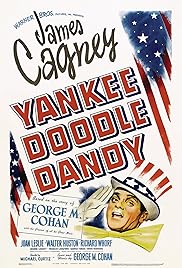YANKEE DOODLE DANDY
(director: Michael Curtiz; screenwriters: Robert Buckner /Edmund Joseph, based on a story by Mr. Buckner; cinematographer: James Wong Howe; editor: George Amy; music: George M. Cohan/Ray Heindorf; cast: James Cagney (George M. Cohan), Joan Leslie (Mary Cohan), Walter Huston (Jerry Cohan), Richard Whorf (Sam Harris), S.Z. Sakall (Schwab), Irene Manning (Fay Templeton), George Tobias (Dietz), Rosemary DeCamp (Nellie Cohan), Jeanne Cagney (Josie Cohan), Captain Jack Young (Franklin D. Roosevelt), Chester Clute (Harold Goff), Frances Langford (Singer), Douglas Croft (George M. Cohan, at 13), Eddie Foy Jr. (Eddie Foy); Runtime: 126; MPAA Rating: NR; producers: William Cagney/Hal B. Wallis/Jack L. Warner; Warner Brothers; 1942)
“James Cagney played George M. Cohan with great vigor and won his only Oscar for that brilliant performance.”
Reviewed by Dennis Schwartz
A genial, spunky, shamelessly-patriotic, but highly entertaining, overlong and slick musical biopic on popular Irish-American showbiz legend George M. Cohan (1878-1942), who was born on the Fourth of July to a struggling vaudeville family, Jerry Cohan (Walter Huston) and Nellie (Rosemary DeCamp), and performed with them and his younger sister Josie (Jeanne Cagney, the star’s sister) as a youngster. They were billed as the Four Cohans. At the time of the film, Cohan was the most influential figure on Broadway. Though not known for its accuracy (Cohan was married twice and neither wife was named Mary) it still according to Cohan’s friends caught his essence and pleased the ailing from terminal cancer Cohan, who saw it at a private screening in his upstate New York hospital. James Cagney played George M. Cohan with great vigor and won his only Oscar for that brilliant performance. The actor, famous for his tough-guy gangster roles, said playing Cohan was the role he was most fond of. For Cagney, it was a return to his showbiz roots where he started out as a vaudeville song-and-dance man. Cohan wrote some 500 musical compositions and/or starred in some 80 Broadway musicals and plays during his long distinguished career.
The director was Hungarian-born Michael Curtiz (Casablanca-1942), the black and white photography was ably shot by James Wong Howe, and the energetic screenplay by Robert Buckner and Edmund Joseph added to the film’s overwhelming success with the public and critics.
The film was released soon after the sneak attack on Pearl Harbor and played as a great morale boost after the U.S. declared war. It played such rousing familiar timeless tunes as the WW I flag-waving “Over There,” “You’re a Grand Old Flag,” “Yankee Doodle Dandy,” and the buoyant “Give My Regards to Broadway.” It was also the first time that a living US President (FDR, played by Jack Young) was portrayed in a motion picture.
It used a flashback framework to shoot a series of unrelated episodes to tell its story. An aging Cohan, who in his comeback has staged yet another Broadway hit play “I’d Rather Be Right,” is summoned to the White House by President Roosevelt. The humbled Cohan, known for his cockiness, then is encouraged by the prez to tell his life story. The flashback begins on July 4, 1878, in Providence, Rhode Island. It follows the Cohan’s barnstorming around the country as vaudeville troupers and their first big break as little Georgie stars in Peck’s Bad Boy, his fortunate partnership with Sam H. Harris and their hit play Little Johnny Jones, and it traces Cohan’s rising fame and fortune during WW1. It reaches its climax when FDR presents Cohan with the Congressional Medal of Honor, and Cagney does an impromptu jubilant tap dance down the White House steps.

REVIEWED ON 7/5/2005 GRADE: B https://dennisschwartzreviews.com/